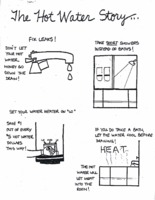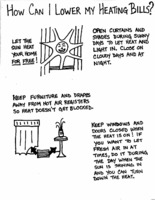See a related article from the Ecology Center's website, Energy Justice Since the ‘70s: Energy Works
Home Energy Works
The Ecology Center began its work on energy issues in the 1970s with curriculum development and a workshop series, but, as more and more families faced the burden of ever-increasing energy bills, there was a growing sense of urgency about the environmental and personal impacts of modern energy consumption. Although the workshops in the fall of 1980 brought in many interested people, the Ecology Center observed that sessions were not effectively reaching populations who were most impacted by surging costs: low-income city residents, minorities, and senior citizens.
In 1981, the Ecology Center transitioned from energy conservation workshops to a more hands-on approach through home weatherization visits, a model that had been successful in other states. As Jim Frey discusses in this video, the Ecology Center was able to use a Community Block Grant to establish connections with other community organizations and contact potential participants. Through this outreach and publicity through articles in the local press, the EC's own Ecology Report, agency referrals, and letters, Ecology Center staff members reached out to the community to find interested low-income tenants and homeowners.
In contrast to traditional energy audits, the Home Energy Works visits could offer specific advice, technical assistance, and empowering do-it-yourself training. During each home visit, two-person crews from the Ecology Center would conduct an inspection, pointing out energy problem areas in the home, and install low-cost or no-cost energy-saving materials. The Ecology Center staff utilized three main strategies: demonstrating temporary measures that required maintenance, installing low-cost permanent technologies that brought substantial savings, and encouraging behavioral changes that supported a low energy-consumption lifestyle. The crew also encouraged tenants or homeowners to be present throughout the visit so that they could maintain and/or re-install any equipment as needed. Education formed an essential element of the Home Energy Works program. At the end of each visit, the Ecology Center crew provided information on further improvements and behavioral changes that could cut costs and reduce energy consumption.
The Home Energy Works program also had the distinct benefit of being able to measure success through tracking the difference in energy bills before and after the home visit. In this video, Hildie Lipson describes a typical walk-through of a client's home during the program's site visits and reflects on the program's success stories. She recalled the story of a local artist who requested advice from the Home Energy Works program:
"We had shown her how to do all this insulation and weatherization, and she went to town ... She sealed up every crack and leak and insulated, and reduced her energy use, and I don’t know if she even cut off space, you know, rooms in her house during the winter, or something. But she had contacted us later to let us know that the energy company had contacted her [because] her energy use had been reduced so much, like had been cut by like 80 or 90 percent that they were like 'Do you still live there? What’s going on?’”
Following up with clients and families who participated the program enabled the Ecology Center to demonstrate that the program was beneficial and could make a difference by saving energy and, in turn, money. This proof would play an important role in securing funding for similar programs across the state of Michigan.





